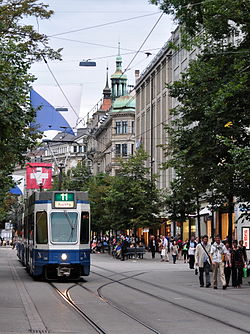Zürich tram route 12

Bahnhofstrasse, Zürich's premier shopping street
|
|||
| Operation | |||
|---|---|---|---|
| Locale | Zürich | ||
| Open | 1882 | ||
| Status | Operational | ||
| Routes | 15 | ||
| Owner(s) | City of Zürich | ||
| Operator(s) | Verkehrsbetriebe Zürich | ||
| Infrastructure | |||
| Track gauge | Metre (3 ft 3 3⁄8 in) | ||
| Propulsion system(s) | Electric | ||
| Electrification | 600 V DC overhead | ||
| Stock | 258 | ||
| Statistics | |||
| Track length (double) | 72.9 km (45.3 mi) | ||
| Track length (total) | 171.9 km (106.8 mi) | ||
| Route length | 118.7 km (73.8 mi) | ||
| Passengers (2012) | 205.0 million | ||
|
|||
| Website | www.vbz.ch | ||
Trams make an important contribution to public transport in the city of Zürich in Switzerland. The tram network serves most city neighbourhoods, and is the backbone of public transport within the city, albeit supplemented by the inner sections of the Zürich S-Bahn, along with urban trolleybus and bus routes as well as two funicular railways and one rack railway. The trams and other city transport modes operate within a fare regime provided by the cantonal public transport authority Zürcher Verkehrsverbund (ZVV), which also covers regional rail and bus services.
The city's trams are operated by the Verkehrsbetriebe Zürich (VBZ), which also manages the tramway infrastructure within the city, but the city's tram tracks are also used by two other operations. The Glattalbahn tram services to the Glattal area to the north of the city interwork with the city tram services and are also operated by the VBZ, although in this case it does so as a sub-contractor to the Verkehrsbetriebe Glattal (VBG). Trains of the independent Forchbahn (FB) light railway also use the city's tram lines to reach their city centre terminus.
Trams have been a consistent part of Zürich's streetscape since the 1880s, when the first horse tram ran. Electrified from the 1890s, they have seen off challenges including proposals to replace them by trolleybuses and by a metro or U-Bahn. With a relatively static city network from the 1930s to the late 1970s, the city's trams have been expanding again since then. Recent expansions have taken the network into the suburbs beyond the city boundary, covering areas it retreated from in the first part of the 20th century. Further extensions have been approved, both to the city tram network itself, and by the introduction of a new light rail system in the Limmat Valley that will interwork with the city trams.
...
Wikipedia

